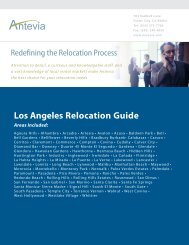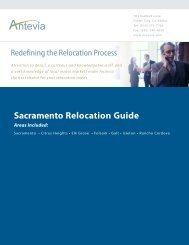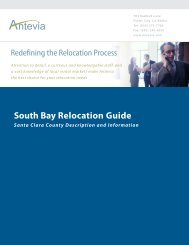San Francisco Relocation Guide - Antevia
San Francisco Relocation Guide - Antevia
San Francisco Relocation Guide - Antevia
Create successful ePaper yourself
Turn your PDF publications into a flip-book with our unique Google optimized e-Paper software.
Chinatown, causing gridlock on roads and public transit, especially on weekends. To<br />
address this problem, the local public transit agency, Muni, is proposing to extend the<br />
city's subway network to the neighborhood via the new Central Subway.<br />
History<br />
The Street of Gamblers (Ross Alley) Arnold Genthe, 1898. The population was<br />
predominantly male because U.S. policies at the time made it difficult for Chinese<br />
women to enter the country.<br />
<strong>San</strong> <strong>Francisco</strong>'s Chinatown was the port of entry for early Taishanese and Zhongshanese<br />
Chinese immigrants from the southern Guangdong province of China from the 1850s to<br />
the 1900s. The majority of shopkeepers, restaurant owners, and hired workers in <strong>San</strong><br />
<strong>Francisco</strong> Chinatown were predominantly Taishanese and male. They had come as<br />
laborers to build California's growing railway networks, most famously the<br />
Transcontinental Railroad or as mine workers or independent prospectors hoping to strike<br />
it rich during the 1849 Gold Rush. With massive national unemployment in the wake of<br />
the Panic of 1873, racial tensions in the city boiled over into full blown race riots. In<br />
response to this, the Chinese residents formed the Consolidated Chinese Benevolent<br />
Association or the Chinese Six Companies, which evolved out of the labor recruiting<br />
organizations for different areas of Guangdong. The xenophobia became law as the<br />
United States Government passed the Chinese Exclusion Act of 1882 – the first<br />
immigration restriction law aimed at a single ethnic group. This law, along with other<br />
immigration restriction laws such as the Geary Act, greatly reduced the numbers of<br />
Chinese allowed into the country and the city, and in theory limited Chinese immigration<br />
to single males only. Exceptions were in fact granted to the families of wealthy<br />
merchants, but the law was still effective enough to reduce the population of the<br />
neighborhood to an all time low in the 1920s. The exclusion act was repealed during<br />
World War Two under the Magnuson Act in recognition of the important role of China as<br />
an ally in the war, although tight quotas still applied.







